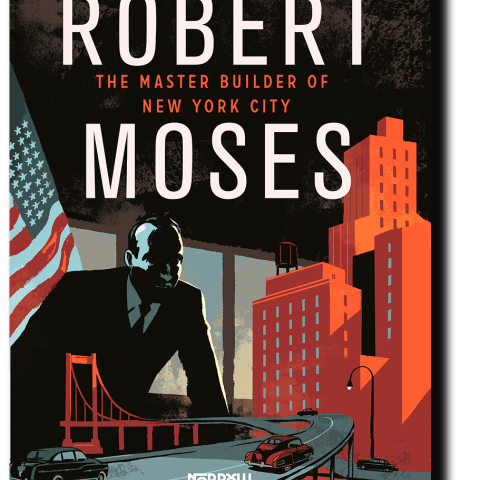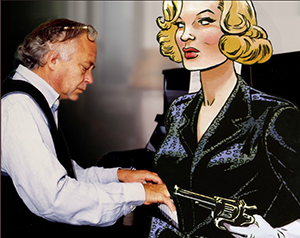Robert Moses (December 18, 1888–July 29, 1981) is one of the most important and influential figures in 20th century American history but few people outside New York know his name. Few architect have done more to redefine the fate of a city — and, by a halo of influence, of cities in general — than Robert Moses. He was one of the most significant visionary architects of New York City, the architect and city designer who erected many features of New York as we know it today – the majestic George Washington Bridge along with the Triborough Bridge and many others; he built freeways and playgrounds, art deco swimming pools and deep tunnels that are still in use today.
A new graphic biography by Pierre Christin and Olivier Balez recounts the achievements of one man who changed the the face of an entire city. Robert Moses: the mastermind of New York.
From the subway to the skyscraper, from Manhattan’s Financial District to the Long Island suburbs, every inch of New York tells the story of one man’s mind: Robert Moses, the architect who designed it all. Now, in Christin and Balez’s graphic biography, the rest of Robert’s story will be told.
A brilliant architect and fierce politician, Moses had “an imagination that leaped unhesitatingly at problems insoluble to other people,” wrote Robert E. Caro in his Pulitzer-winning, 1,200-pages biography The Power Broker — one of the most impressive books ever written in the English language — tracing how Moses slowly changed from “the optimist of optimists, the reformer of reformers, the idealist of idealists” into a man who used “iron will and determination” to bend a city, perhaps the world’s greatest city, to his will. That uncompromising willpower and its fruits would eventually lead the great urbanist Lewis Mumford to proclaim that “the influence of Robert Moses on the cities of America was greater than that of any other person.”
Nobrow editorial has a terrific graphic novel biography of Robert Moses available, newly translated to English (first was in French and German), which is written by the legendary French comics writer Pierre Christin and illustrated by the Chilean Olivier Balez. The authors chronicle this almost Randian figure in architecture and urban planning, who was driven to re-shape New York into his global vision. Certain of his colossal proposals, however, would overstep the mark, such as the ten-lane Lower Manhattan Expressway, successfully opposed by activist Jane Jacobs.
Ironically, Christin and Balez point out that it is Jacobs who is commemorated with a day in her honour, while Moses’ name remains obscure to many; their elegant, insightful portrait should help to correct that.
However the graphic novel does not waive to show us also the other face of Moses. The dark face of this power-hungry character and his dehumanizing ideal, by his industrial vision, are revealed gradually. On midway through the book as his counterpoint emerges: Jane Jacobs, "saint of urbanism" and her legendary vision about the human-centered city, enters the scene, via her bicycle, on which she was known pedaling through New York.
“Have no fear of change as such and, on the other hand, no liking for it merely for its own sake.”
Robert Moses.
“Cities have the capability of providing something for everyone, only because, and only when, they are created by everybody.”
Jane Jacobs.
Robert Moses: The Master Builder of New York City (Hardcover).
By (author).- Pierre Christin, Olivier Balez.
Hardcover.- 104 pages.
Publisher.- Nobrow Press (December 23, 2014)
Language.- English
ISBN-10.- 1907704965
ISBN-13.- 978-1907704963
Dimensions.- 20.8 x 27.8 cm




































